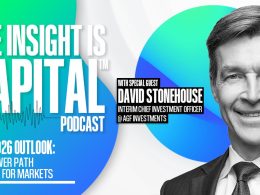by Wylie Tollette, Franklin Templeton Investments
In the decade since the global financial crisis, many investors have either actively steered—or ended up with—a large portion of their portfolios in investments tied to economic growth, namely stocks. However, as global growth begins to slow, Wylie Tollette, Head of Client Investment Solutions, Franklin Templeton Multi-Asset Solutions, thinks it’s a good time for growth-focused investors to do a portfolio check-up.
On April 9 of this year, the International Monetary Fund cut its 2019 outlook for global growth to the lowest level since 2009—the tail end of the global financial crisis (GFC).1 As a result, many investors may be wondering if slowing growth is likely to lead to a worldwide recession or repeats of the sort of volatility we saw towards the end of last year.
Although we do not see a high probability of a recession in the near term, we do think global markets entered a new volatility regime in 2018. Before last year, volatility had been relatively low after the GFC, due to measures taken by central banks to stimulate their economies. As that intervention slowly abates, we expect volatility to return to more normal “baseline” levels.
In our view, as overall global growth slows, uncertainty around predictions of forward interest rates, inflation and corporate earnings may increase. Since markets like certainty, we think volatility is likely to be higher in the next few years than it has been over the last few years.
Against this backdrop, we would urge investors, particularly those with larger portions of their portfolios tied to global growth, to consider three activities to prepare their portfolios for the potential return of what we’d consider as normal market volatility.
#1: Understand Your Time Horizon
In the institutional world, understanding your time horizon comes down to “asset liability management”, or making sure that you don’t have short-term liabilities and long-term assets, or vice versa. Said simply, what is the money for and when is it needed? If it is required sooner rather than later, one should consider that need in the asset allocation.
Investors nearing retirement with expected cash flow demands need to ensure they are setting themselves up for success by avoiding the forced sale of longer-term, growth-driven assets. Conversely, younger investors with many years before retirement have a longer time horizon. In that case, moderate market downturns might be their friend in terms of adding to their investments at lower price points.
When you need to rely on your investments to meet the short-term obligations of day-to-day living expenses, it’s a real issue if most of your investments are long term in nature. It can turn you into a forced seller during down markets, a sure-fire way to buy high and sell low—the exact opposite of your intention. Alternatively, when one has a long-term goal like retirement, holding shorter-term assets can lead to a sub-optimal outcome in the long term.
Whether you are a pension fund manager or an individual investor, understanding what the money is for and when it is needed should be the first step to improving the probability of achieving your goals.
#2: Stress Test Your Portfolio
Before the GFC, many investors thought they understood their capacity for risk. But they learned a lesson. Many found out they had bitten off more than they could stomach once they experienced that risk in real time.
Like dealing with wildfire, the time to establish “defensible space” in your portfolio is before the fire starts. Stress testing your portfolio for more volatile markets—so-called “tail-risk events”—can provide a necessary gut check.
Stress testing can also help identify exposures to the vagaries of economic growth that may be hiding in a variety of unexpected spots in your portfolio. We think investors should assess their exposures not just in equities, but also in corporate bonds, real estate and in their employment income. Even certain municipal bonds—particularly those tied to economic development projects—are linked to economic growth as an underlying driver.
We think investors should consider all these exposures in their stress-testing scenarios and when understanding and calibrating their actual capacity for risk.
#3: Diversify Across Asset Classes
We see the value in diversification across many different asset classes. In other words, employing diversification can lead to similar returns at lower risk, or higher returns at the same risk.
Since the GFC, many investor portfolios may have built up exposure to assets tied to economic growth such as stocks, corporate bonds, growth-sensitive real assets and emerging-market bonds. We generally advocate for some degree of diversification into other more defensive return drivers like interest rates, inflation and real assets.
Many investors feel that some government bond exposure is usually a rational allocation, despite the relatively low expected returns compared to stocks. Government bonds can provide liquidity and an opportunity for rebalancing after a stock market re-rating, and can help cushion the psychological blow of a dramatically lower account market value. Even very long-term investors like pension plans and endowments maintain an allocation to interest-rate-sensitive assets for these reasons, despite the possibility of lower rates of return over the longer term.
Real assets are another area where investors have been able to find diversification within a broader portfolio that is dominated by stocks and bonds, in our experience. Many investors may not understand the characteristics and varied risk-factor exposures of the asset class. For example, core commercial real estate that is already fully leased to a reliable tenant likely has exposure to both economic growth and interest rates, because of the leverage embedded in most commercial real estate. The same real estate may provide some hedge against inflation as well depending on the tenant’s lease terms.
Finally, for long-term investors with regular cash-flow demands, steady income can be an important attribute. This can mean selecting income-producing stocks, increasing overall fixed income allocations or choosing real estate and infrastructure investments with an income component. This approach can allow cash-flow constrained investors to continue holding those longer-term assets through various market environments—and not be forced into the aforementioned short-term selling decisions to meet short-term cash-flow needs.
Tying It All Together
As humans, we are naturally subject to a variety of behavioral flaws and biases that can influence our investment decision making. Recency bias, loss aversion and mental accounting are some of the more prominent biases that can influence even the most sophisticated investors.
At Franklin Templeton Multi-Asset Solutions, our approach is to consider the three steps above to maintain a longer-term view and mitigate the impact of these biases as we look to navigate changing market environments.
Data from third-party sources may have been used in the preparation of this material and Franklin Templeton Investments (“FTI”) has not independently verified, validated or audited such data. FTI accepts no liability whatsoever for any loss arising from use of this information, and reliance upon the comments, opinions and analyses in the material is at the sole discretion of the user. Products, services and information may not be available in all jurisdictions and are offered by FTI affiliates and/or their distributors as local laws and regulations permit. Please consult your own professional adviser for further information on availability of products and services in your jurisdiction.
The comments, opinions and analyses expressed herein are for informational purposes only and should not be considered individual investment advice or recommendations to invest in any security or to adopt any investment strategy. Because market and economic conditions are subject to rapid change, comments, opinions and analyses are rendered as of the date of the posting and may change without notice. The material is not intended as a complete analysis of every material fact regarding any country, region, market, industry, investment or strategy.
To get insights from Franklin Templeton delivered to your inbox, subscribe to the Beyond Bulls & Bears blog.
For timely investing tidbits, follow us on Twitter @FTI_Global and on LinkedIn.
What Are the Risks?
All investments involve risks, including possible loss of principal. The value of investments can go down as well as up, and investors may not get back the full amount invested. Stock prices fluctuate, sometimes rapidly and dramatically, due to factors affecting individual companies, particular industries or sectors, or general market conditions. Bond prices generally move in the opposite direction of interest rates. Thus, as the prices of bonds in a fund adjust to a rise in interest rates, a fund’s share price may decline. Changes in the financial strength of a bond issuer or in a bond’s credit rating may affect its value. High yields reflect the higher credit risk associated with these lower-rated securities and, in some cases, the lower market prices for these instruments. Interest rate movements may affect the share price and yield. Treasuries, if held to maturity, offer a fixed rate of return and fixed principal value; their interest payments and principal are guaranteed.
_________________________________
1. Diversification does not guarantee profits or protect against risk of loss.
Copyright © Franklin Templeton Investments














